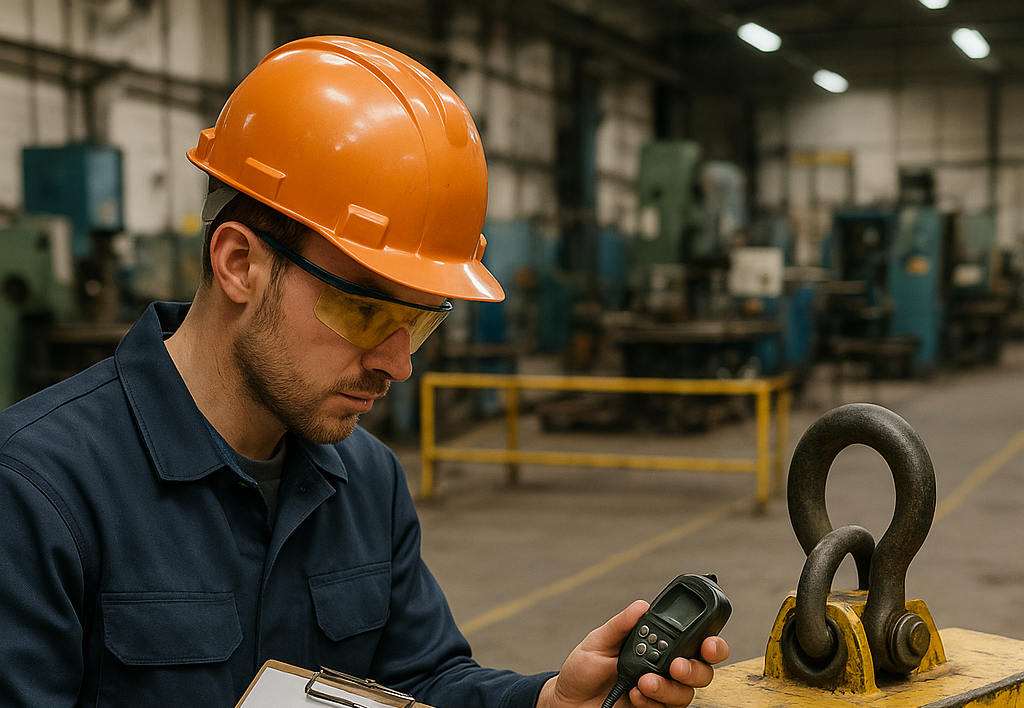5901 Botham Jean Blvd, Dallas, TX 75215
Learn the Process for Decommissioning a Magnetic Lifting System?
July 26, 2025Decommissioning a magnetic lifting system involves safely removing it from service at the end of its operational life or when it requires replacement. This important process includes specific steps to protect workers, equipment, and the environment, while adhering to industry regulations.
Proper decommissioning of magnetic lifting systems requires careful planning and execution by qualified personnel. These systems, which utilize powerful magnetic fields to lift and move ferrous materials, contain components that must be handled according to safety protocols to prevent accidents and equipment damage.
Industry standards such as ASME B30.20 govern the decommissioning process for below-the-hook lifting devices, including magnetic systems. These standards outline inspection requirements, documentation procedures, and safety protocols that must be followed when taking these tools out of service. Adhering to these guidelines ensures a safe, efficient, and compliant decommissioning process.
What Safety Precautions Are Essential When Decommissioning Magnetic Lifters?

Safety must be the top priority when decommissioning magnetic lifting systems. These powerful devices store significant energy and require specific procedures to prevent accidents and injuries. Following established safety protocols protects both personnel and equipment during the decommissioning process.
The first step in safe decommissioning is proper power isolation. All sources of lifting magnet power must be disconnected, locked out, and tagged as “Out of Service.” This prevents accidental energization during maintenance work. A magnetic lifter removed for repair should also be clearly tagged to prevent unauthorized use.
Fluid pressure presents another hazard during decommissioning. Pressure must be fully relieved from all circuits before loosening or removing any fluid power components. Stored pressure can cause components to move unexpectedly or eject with significant force.
Personnel Requirements and Restrictions
Only designated personnel should perform adjustments, repairs, and testing on magnetic lifting equipment. These individuals should have appropriate training and understanding of the specific equipment. Limiting access to qualified workers reduces accident risks.
When replacing parts, use components that meet or exceed the original manufacturer’s specifications. Substandard replacement parts may compromise the equipment’s integrity and create safety hazards. Maintain detailed records of all repairs and replacements for future reference.
Electrical Safety Considerations
Magnetic lifters contain electrical components that require careful handling. Never disconnect an electromagnet from its energy source while energized, as this can cause dangerous electrical arcing that may result in serious injury.
Battery-operated electromagnets need special attention. Proper handling of batteries and electronic components is crucial. Check for any damaged wiring or connections that could create electrical hazards. Maintain appropriate battery electrolyte levels and clean any corrosion from battery posts and connectors.
Testing and Certification Requirements
After completing decommissioning or repairs, the magnetic lifter must undergo inspection before returning to service. This should follow the equipment manufacturer’s periodic inspection guidelines, verifying that all components function properly and safely.
For altered or repaired lifting magnets, testing may be limited to the components affected by the alteration or repair. A qualified person should determine the scope of necessary testing. All test results must be documented and filed for future reference.
Environmental Considerations
Proper disposal or recycling of magnetic lifting equipment components is an important safety consideration. Follow local regulations for recycling electronic components, batteries, and other materials. Improper disposal can create environmental hazards and may violate regulations.
When decommissioning permanent magnets, be aware they maintain their magnetic field even when powered down. They can still attract ferrous objects unexpectedly. Handle with appropriate caution to prevent pinch injuries or damage to sensitive equipment nearby.
| Safety Precaution | Description |
| Power Isolation | Disconnect, lock out, and tag all power sources as ‘Out of Service’ to prevent accidental energization during maintenance. |
| Fluid Pressure Relief | Fully relieve fluid pressure from all circuits before loosening or removing any components to avoid unexpected movements or ejections. |
| Personnel Requirements | Only designated personnel with appropriate training should perform adjustments, repairs, and testing. |
| Part Replacement | Use components that meet or exceed the original manufacturer’s specifications to prevent safety hazards. |
| Electrical Safety | Never disconnect an electromagnet from its energy source while energized to avoid electrical arcing. |
| Battery Maintenance | Check for damaged wiring, maintain battery electrolyte levels, and clean corrosion from connectors. |
| Inspection and Testing | Conduct inspections and testing as per manufacturer’s periodic guidelines and document all findings. |
| Environmental Considerations | Follow local regulations for recycling or disposing of electronic components, batteries, and other materials to prevent environmental hazards. |
The decommissioning process should be methodical and deliberate. Rushing through safety procedures increases risk. Take time to follow each step correctly and thoroughly. Document all steps taken during decommissioning for future reference and compliance purposes.
How Should Inspections and Testing Be Conducted During Decommissioning?

Inspections and testing are essential for any successful decommissioning project. These critical procedures ensure environmental compliance, worker safety, and proper material handling throughout the process. A systematic approach to inspections helps prevent potential hazards and maximizes the recovery of recyclable materials.
Visual Inspections: Your First Line of Defense
Regular visual inspections serve as the frontline assessment method during decommissioning. Conduct these inspections frequently to identify potential issues before they become serious problems. Inspectors should look for visible signs of damage, contamination, or deterioration that could affect safety or recycling potential.
Train personnel to identify key indicators such as corrosion, leaks, structural weakness, and improper connections for effective visual inspections. Document all findings with photographs and detailed notes to establish a clear record of site conditions throughout the decommissioning process.
Periodic Documented Inspections
Beyond regular visual checks, schedule comprehensive documented inspections at strategic intervals during the decommissioning process. These formal assessments evaluate external conditions and system integrity according to established industry standards and regulatory requirements.
The frequency of these inspections should be determined by the facility’s complexity, the types of materials present, and regulatory requirements. For standard industrial facilities, monthly documented inspections are typically sufficient, while sites with hazardous materials may require more frequent assessments.
Specialized Testing Procedures
Certain components require specialized testing beyond visual inspection. For electrical equipment, tests like coil resistance and ground insulation are essential to ensure safety before handling and determine recycling potential. These assessments help verify the condition of materials and equipment before processing.
Coil resistance testing measures the electrical resistance across coils in motors, transformers, and similar equipment, identifying potential shorts, opens, or damaged windings that could pose safety hazards. Ground insulation testing verifies the integrity of electrical insulation between conductive components and ground, helping prevent electrical accidents during dismantling.
For facilities with idle equipment such as magnets or motors, testing becomes even more critical. The longer equipment remains unused, the more thorough the testing should be before handling. Equipment idle for less than a month may require basic visual inspection and electrical testing, while equipment unused for years demands comprehensive assessment including insulation resistance testing, polarization index testing, and mechanical integrity verification.
Inspection Checklist for Decommissioning Projects
To ensure consistent and thorough evaluations, decommissioning teams should follow a structured inspection checklist that includes:
- Site perimeter security and access control verification
- Structural integrity assessment of buildings and equipment
- Hazardous material identification and containment evaluation
- Electrical system isolation confirmation
- Environmental monitoring system functionality checks
- Waste separation and containment area inspection
- Personal protective equipment adequacy assessment
- Emergency response equipment readiness verification
- Documentation and record-keeping compliance check
Environmental Monitoring During Decommissioning
Environmental testing is a crucial component of the inspection process. This includes air quality monitoring for dust and potential contaminants, water sampling for leaching or runoff issues, and soil testing in areas where materials have been stored or processed. Environmental monitoring should continue throughout the decommissioning process and often extends beyond project completion to ensure no lasting impact.
Real-time monitoring systems can provide immediate alerts if environmental parameters exceed acceptable thresholds, allowing for prompt corrective action. These systems are particularly valuable for sites with potential contaminants or where decommissioning occurs near sensitive ecological areas or communities.
Regulatory Compliance Verification
Inspections must also verify compliance with all applicable regulations, including ensuring proper permits are obtained, required notifications are submitted, and all waste management practices meet local, state, and federal requirements. Regulatory inspections may be conducted by external agencies, so maintaining comprehensive internal inspection records is crucial for demonstrating due diligence.
The recycling industry faces especially stringent regulations regarding the handling and processing of materials during decommissioning. Regular compliance inspections help prevent violations that could result in penalties, project delays, or environmental damage.
| Time Period | Inspection Type | Frequency |
|---|---|---|
| Pre-decommissioning | Visual Inspections | Frequent |
| Active Decommissioning | Documented Inspections | Monthly (or more frequent for hazardous sites) |
| Post-Decommissioning | Environmental Monitoring | Throughout and beyond project completion |
Successful decommissioning depends on thorough inspection and testing protocols tailored to each project’s specific requirements. By implementing systematic inspection procedures, companies can ensure safety, regulatory compliance, and optimal recovery of recyclable materials throughout the decommissioning process.
What Documentation is Required for Magnetic Lifter Decommissioning?

Comprehensive documentation is crucial for an effective magnetic lifter decommissioning process. The records you keep serve both safety and compliance purposes, safeguarding workers and organizations from potential hazards and liability issues.
Every decommissioning project demands detailed paperwork from start to finish. The documentation process starts with a formal decommissioning plan outlining the scope, schedule, responsible personnel, and specific procedures for safely taking the magnetic lifter out of service.
Essential Documentation Components
Several key documents must be maintained throughout the decommissioning process:
- Inspection Records: Include all historical inspection reports, test results, and maintenance logs that give insight into the lifter’s operational history and condition.
- Repair Documentation: Records of any repairs, alterations, or part replacements performed during the magnetic lifter’s service life.
- Test Reports: Results from operational tests, load tests, breakaway force tests, and design factor tests conducted throughout the lifter’s service.
- Compliance Certification: Documentation confirming that the magnetic lifter met ASME B30.20 standards and other applicable regulations during its operational life.
These historical records provide valuable context during decommissioning, especially when determining safe handling procedures or potential hazards.
The Magnet Decommissioning Form
Central to the documentation process is the Magnet Decommissioning Form, which must include:
- Model number, serial number, and rated capacity of the magnetic lifter
- Manufacturer information and date of manufacture
- Organizational contact details for the decommissioning team
- Reason for decommissioning (obsolescence, damage, upgrade, etc.)
- Future intentions for the system (disposal, recycling, storage, etc.)
- Detailed schedule for each step of the decommissioning process
- Verification signatures from qualified personnel overseeing the process
This form serves as the official record of the decommissioning event and must be completed with precision and thoroughness.
Record Retention and Accessibility
Organizations must maintain decommissioning records for a minimum period specified by regulatory authorities, usually at least five years. These records should be stored in both physical and digital formats to ensure long-term accessibility. During the actual decommissioning process, copies of relevant documentation should be physically attached to the magnetic lifter to provide immediate reference for technicians.
Beyond compliance requirements, thorough documentation protects organizations from potential liability issues by demonstrating that proper procedures were followed. Comprehensive records are also valuable if the equipment is later restored to service or if components are repurposed.
Documentation Best Practices
When preparing decommissioning documentation, follow these guidelines:
- Use standardized forms and formats for consistency
- Include detailed photographs of the magnetic lifter before and during decommissioning
- Document any unexpected issues encountered during the process
- Maintain a clear chronological order of all decommissioning activities
- Have qualified personnel review and verify all documentation for accuracy
Organizations with robust documentation systems experience fewer complications during decommissioning and maintain better compliance records.
Proper documentation represents more than regulatory compliance—it reflects a commitment to safety and responsible equipment management throughout the complete lifecycle of magnetic lifting equipment.
| Documentation Component | Description |
| Inspection Records | Detailed reports of historical inspections, test results, and maintenance logs throughout the magnetic lifter’s operational history. |
| Repair Documentation | Records of repairs, alterations, and part replacements performed during the lifter’s service life. |
| Test Reports | Results from operational, load, breakaway force, and design factor tests conducted throughout the service life of the lifter. |
| Compliance Certification | Documentation confirming adherence to ASME B30.20 standards and other applicable regulations throughout the lifter’s operational life. |
Conclusion: Ensuring a Safe and Compliant Decommissioning Process
Decommissioning magnetic lifting systems requires meticulous attention to detail and adherence to established safety protocols. The process involves careful planning, systematic execution, and thorough documentation to ensure worker safety and regulatory compliance. When conducted properly, decommissioning not only prevents potential accidents but also facilitates the responsible disposal or repurposing of valuable system components.
Throughout the decommissioning process, organizations must prioritize the isolation of power sources, proper inspection of all system components, and verification testing to confirm complete demagnetization. Adherence to industry standards such as LOLER and PUWER regulations ensures the procedure maintains the highest safety standards. By following manufacturer guidelines for disassembly and maintaining comprehensive records of the decommissioning process, companies demonstrate their commitment to worker protection and environmental responsibility. For expert guidance on safely decommissioning and properly recycling your magnetic lifting equipment, contact Okon Recycling at 214-717-4083.
